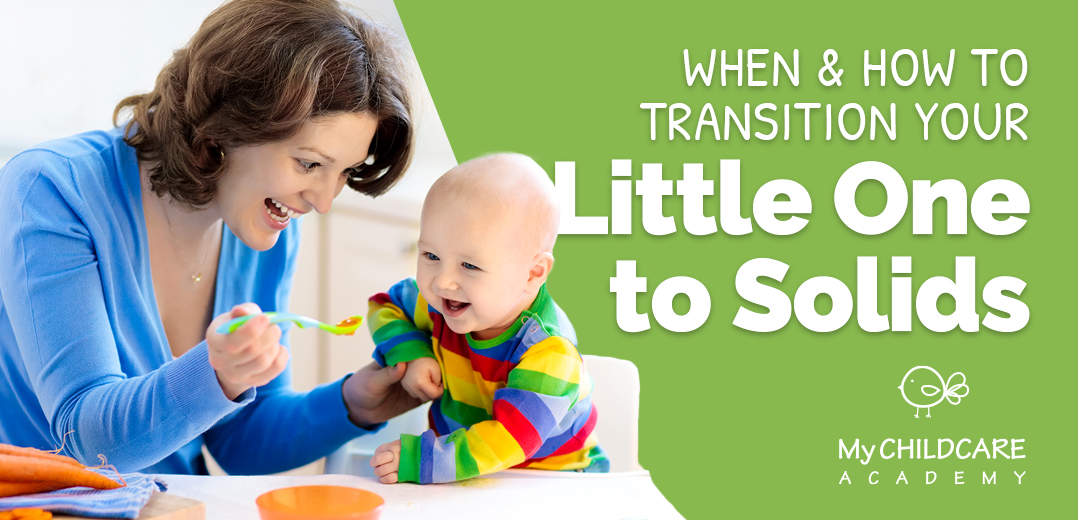
When & How to Transition Your Little One to Solids
As your little one is growing, you may be wondering, when is it the right time to transition them from breast milk or infant formula to solids? When you introduce solids to your baby, you’re helping them hit a huge developmental milestone. You’re not just teaching them how to eat but also how to chew, bring food to their mouths, grasp small items, and oral motor skills that help them with speech later on. As they are introduced to more foods they become more aware of different tastes, smells, and food textures. If you aren’t sure when or how to transition your little one to solids, we are here to guide you through the transitioning process.

When Do I Know My Baby Is Ready for Solids?
It is recommended that children are introduced to solids when they are at least 6 months old. However, every child is different and there are a few ways to help you determine if your child is ready. Here are some of the signs you want to watch out for:
- Your child can sit up alone without help or support
- They are able to open their mouths when you offer them food
- They have good neck and head control
- Reaches out for food and shows interest when you are eating
- Is able to hold small objects and bring them to their mouth
- Swallows food and does not push it out
The best way to know when your child is ready mainly depends on how they are currently developing. You never want to give them solids before they are 4 months old.
How to Introduce Solids to Your Child
There are a few ways to go about transitioning your child over to solid foods. Here are a few ways to begin introducing new foods:
Take It Slow
It is best to teach your child how to adapt to the transition by starting off simple and not rushing things. When you take the process slow, you are able to identify any types of allergic reactions. As you offer single-ingredient foods, be sure to wait a few days before introducing another food. It’s best to take it slow and introduce one food at a time. One good option is to try infant cereals and oatmeal. When preparing baby cereals, you can add in breast milk or formula so that they are starting with a flavor they know and are comfortable with. You can also change the texture of the cereal based on how much liquid you add, which can be helpful as your child learns to navigate thick and thin foods.
Gradually Introduce Vegetables and Fruits
When introducing fruits and vegetables, it is always best to serve them as Puréd or mashed. Again, avoid mixing any foods and offer them up as a single-ingredient to be fully aware of any types of reactions to foods. It is also important to remove any seeds before preparing or serving any kinds of fruits.
Iron & Zinc
High-iron and zinc foods are vital nutrients for your child’s growth and neurologic development. A few ideas on how to incorporate these into your infant’s diet are puréed meats and beans, which are excellent sources of iron. While peas, beans, chickpeas, cheese, and yogurt are all great sources of zinc.
How to Prep Solid Foods for Your Child
Softer textures are best for your little one to transition to when developing chewing, swallowing, and motor skills. Puréed or mashed foods are best and you may want to consider investing in a food processor or blender.
Preparing foods that are the right size, portion, and smooth in texture are the best way to prevent your child from choking. It’s important to avoid foods that are hard or sticky when transitioning to solids. Be sure to only prepare foods that are easier for your child to swallow. Don’t rush the process as your child is adjusting and developing new oral skills.
Here are some ways to prepare your child’s food:
- Mash fruits and veggies with a fork until they are smooth and easy to swallow.
- Remove any kind of fat, bones, or skin before you begin cooking meat or fish.
- Foods like grapes, berries, string cheese, or hot dogs should be cut up into pieces no larger than ¼ of an inch. (You should wait to incorporate these foods until your child has mastered chewing and swallowing. These are high-risk choking hazards even when they are cut up properly)
- Cook and mash up any wheat, grains, or barley well.
Never leave your infant unattended when they are eating. We recommend taking a CPR and First Aid class from your local fire department so you can feel prepared and know what to do if your little one ever chokes.

Is Your Little One Ready for Daycare?
At My Childcare Academy we offer childcare for 6 month-olds who are just learning how to transition to solids. To ensure the health and safety of each child, we offer a diverse array of healthy foods and practice safety measures in preparation of each meal. Each of our classrooms are specific to your child’s age and development. In our 6 week to 9 month classroom, you can expect your little one to focus on hitting milestones; such as, crawling, sitting, clapping, and eating. Aside from their gross motor skills, this age group is also working on early language skills and different ways to learn about their world through sensory and play. For more information on our school and programs, call us today!
